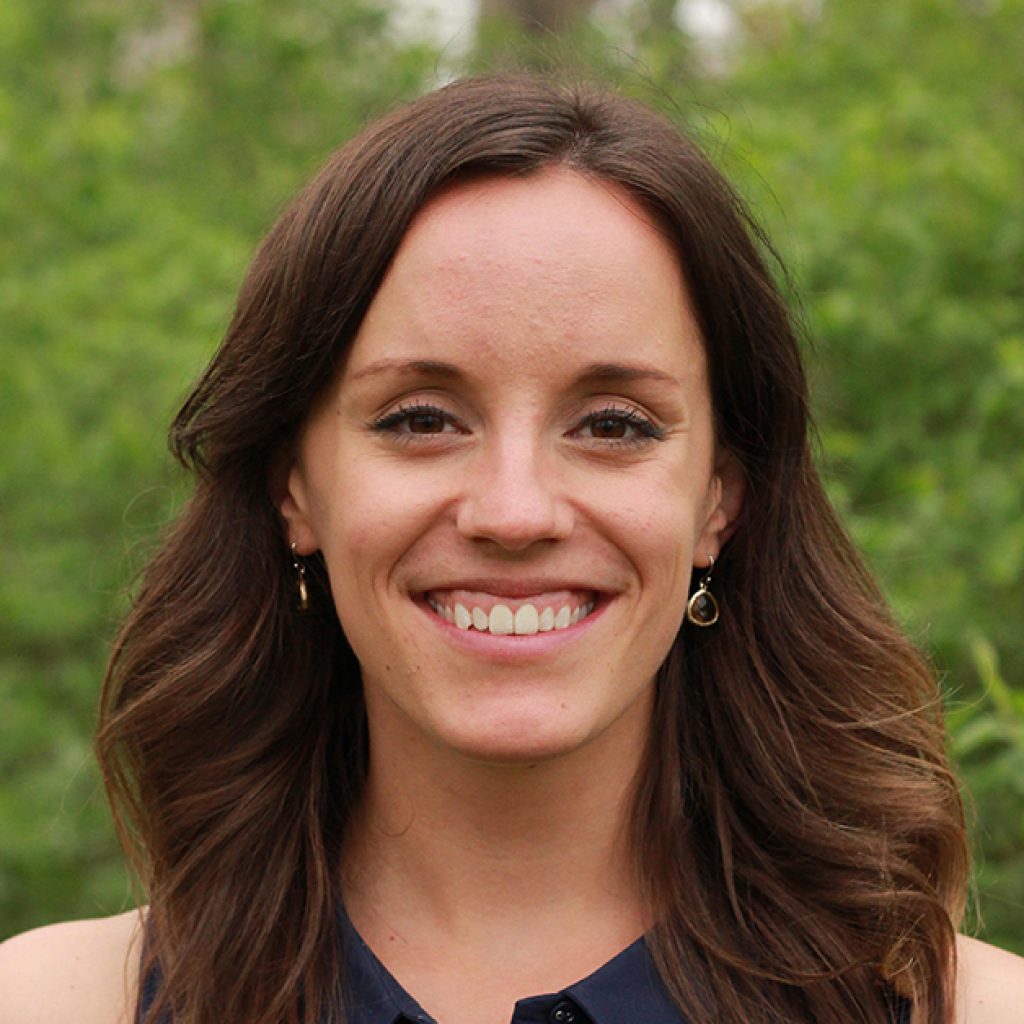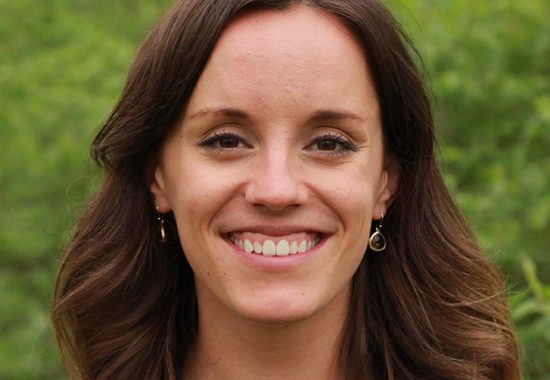
Erica Barhorst-Cates, PhD has served as a Postdoctoral Fellow at MRRI in the Cognition and Action and Cognitive Motor Learning Labs since August 2019. She sat down with us to talk about life in the lab, her exciting research and scientific career as well as her personal passions.
1) Tell us more about your academic background and training
I received my PhD in Psychology in 2019 from the University of Utah with a specialty in Cognition and Neural Science. While I primarily worked with neurotypical young adults in graduate school, I’ve conducted research across the age spectrum working with neurotypical children and older adults. My research topic focuses on spatial cognition or the way we perceive and interact with the world around us. Through this research, I hope to provide a better understanding of individual differences in spatial cognition, whether due to age, gender, visual status, or movement experience. For example, much of my prior work focused on understanding how low vision caused by disease or temporary visual restrictions impacts spatial navigation. I also conducted research to understand how experience with sports and other highly-trained movement activities (such as dance) affects spatial-cognitive abilities. Aside from movement, I researched how a person’s experience in different environments (e.g., rural versus urban) impacts their ability and strategies for spatial navigation. In my research, I have used different methods such as real-world navigation, virtual reality (VR), and more recently, kinematic motion analysis.
2) What attracted you to science and the field of neurorehabilitation?
I was initially attracted to science because I wanted to understand how people with unique and highly-trained skillsets may perceive and understand the world differently than others. I grew up with a ballet studio as a second home and gained a fascination with how an individual’s dancing experiences could shape their cognitive abilities. Do dancers have better spatial memory for sequences of movements? Are dancers better at imagining movements, or are they more likely to need to directly experience and manipulate things to understand them? Most interestingly, if dancers do have unique or better cognitive abilities in certain realms, can we use dance as a way to improve those abilities in other individuals?
These questions guided my previous work and inspired me to pursue postdoctoral training in the field of neurorehabilitation. Since early in my research career, I have longed to do work that could eventually help people. As an undergraduate, I developed and taught a year-long Dance Movement Therapy class for children with Autism and loved the more direct application of research. While my graduate work focused on understanding the spatial abilities of neurotypical individuals, especially those possessing particularly good spatial abilities, my postdoctoral research has aimed more at understanding how stroke may impair spatial abilities. Although I do not directly work on therapeutic approaches, my hope is that one day my research could inform the development of new treatments.
3) Why did you choose to work at MRRI?
I chose to work at MRRI because of the patient-focused research and the availability of advanced research equipment, including virtual reality, motion tracking, and robotic testing devices. For many years, I wanted to do more applied research with patient populations. MRRI provides the perfect setting to do so. I was very interested in the research questions addressed by Laurel Buxbaum, PsyD, and Aaron Wong, PhD, which also attracted me to the institute.
4) What are some of the research questions you currently working to address?
I currently have two primary lines of work: one related to movement imitation and one related to spatial navigation. Along with my colleagues Dr. Buxbaum, Dr. Wong, and Mitchell Isaacs, we recently completed a project aimed at understanding how people imitate movements using kinematic motion tracking in young neurotypical adults. We currently are working on another project with the goal of better understanding movement imitation in stroke patients. In this study, we are using virtual reality to identify which spatial perspective (first-person or third-person) is best for viewing and learning an upper arm movement.
I’m also excited to say that I was recently awarded an Albert Einstein Society research grant to pursue a project aimed at understanding navigation deficits after stroke. We argue that navigation deficits may be underreported in stroke because the currently-used assessments do not fully capture the extent of impairment. While prior work primarily tested patients’ abilities to perform navigation tasks through self-report questionnaires or on desktop computer simulations, our study will have participants navigate through the MRRI building and learn the locations of landmarks. Patients also will complete several measures to assess their skill with walking, turning, and completing cognitive tasks. We will relate participants’ performances on these measures to their performances on the navigation task to identify factors that could relate to spatial navigation.
5) What have been some of the key findings of your research?
In our first movement imitation study, we found that people can imitate movements either by paying attention to the motion of the hand through space or by paying attention to how the arm is configured. This is exciting because it suggests that there are multiple ways to instruct a person on how to successfully imitate, which is a key component of motor learning. If an individual has difficulty with one type of imitation (matching their limb positions to the limb positions of another person), a therapist could instruct a patient to use an alternate imitation method, which could improve movement recovery outcomes. While we have so far only studied this phenomenon in neurotypical individuals, we hope to begin a study with patients who experienced a stroke.
6) Can you tell us more about the impact or potential impact of your research?
Spatial navigation is an activity linked to maintaining a high quality of life. The results from the navigation study should tell researchers which measures are most sensitive in predicting difficulties with navigation. These findings are important because, as previously mentioned, we have reason to believe that navigation difficulties are underreported in individuals with stroke. This is because spatial navigation is rarely queried in rehabilitation and the measures used by many researchers have not assessed people’s abilities in real-world situations, where navigators must remember locations and route information while also maintaining balance, walking, turning, and paying attention to their surroundings. Our real-world navigation test and background battery of tests should allow us to more accurately understand how stroke may impair a person’s navigation and other related abilities.. These results could help identify individuals who have difficulty with navigation, thus also identifying individuals who may benefit from targeted rehabilitation.
7) What is one of the biggest challenges faced in your work?
One of the biggest challenges for me is determining how to measure and study some of the complicated cognitive and physical processes in which I’m interested. For instance, spatial navigation is a complex activity that involves so many processes that it becomes difficult to isolate and study a single component. The complex real-world behavior of spatial navigation that does not occur as an isolated event is actually an exciting reason to study it. .When navigating, people almost always simultaneously do multiple tasks. There also are individual differences in experience with navigating, skill, priorities, anxiety, and strategies that influence a person’s ability and behavior. In addition, navigation is an extremely important activity for daily functioning, and one that declines even in healthy aging for various reasons – some which are known and some which still must be undetermined. While I find it all fascinating, the complexity makes it challenging to study.
8) What do you see as the next step in your career? Will any experiences or skills from your fellowship at MRRI be particularly useful going forward?
I still have about a year and a half of my postdoctoral fellowship, and I’m not sure exactly of my next step. I would, ultimately, love to become a professor in a psychology department at a university with a versatile research program that includes both patient and neurotypical populations. Once my husband finishes his medical residency in Family Medicine, I likely will apply to universities and see where life takes us. In the meantime, I aim to learn and experience as much as possible!
During my fellowship, I have learned many important skills and had many experiences that I will take with me wherever I go: from sophisticated data analysis techniques and how to use a critical approach to the ins and outs of grant acquisition. I also learned to think about the translational implications of research, which I believe is an extremely important component of science that is sometimes lost. Finally, I have met wonderful people and colleagues who I now consider as friends that I’d like to have for the rest of my life.
9) What is one of your favorite MRRI memories?
Our lab decided to go on a socially-distanced kayaking trip down the Brandywine River in September, which was a lot of fun. More than ten of us each had our own kayaks and took turns navigating the “rapids” and spotting bald eagles. It was such an enjoyable lab outing and so beneficial to get out into nature and reset! I am glad to be a part of a group of individuals who value both work and play.
10) What do you like to do in your free time?
I am an avid outdoors enthusiast and really love hiking, camping, kayaking, and spending time in nature with my husband. I’m very active and love dancing, yoga, and working out. I also am a fervent reader of both fiction and non-fiction books. I am especially passionate about traveling. I love planning trips—researching and visiting new places, meeting new people, and trying new foods. To mitigate my wanderlust during quarantine, we have done a lot of gardening and cooking/baking..


2 comment on “Get to Know MRRI Postdoctoral Fellow Erica Barhorst-Cates”